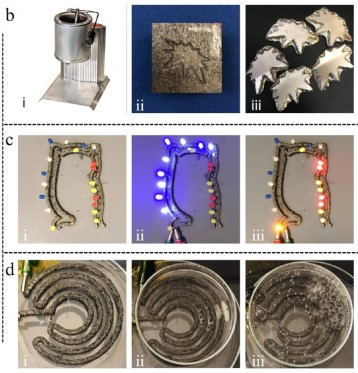A team of researchers from Rice University, Texas, have developed a new method of fabricating complex graphite structures using direct ink writing (DIW) 3D printing.
Previous attempts to 3D print with graphite have usually involved integrating a powdered form of the material into a polymer matrix. Using extrusion-based technologies, it’s then possible to create mechanically sound structures, but the resulting composites often only comprise less than 50% graphite by weight. As such, 3D printed graphite parts until now haven’t really offered the thermal and electrical properties that make pure graphite so desirable.
To tackle the problem, the Rice researchers developed a colloidal 3D printable ink made of graphite powder and miniscule amounts of clay, achieving complex DIW parts with up to 97% purity.

Graphite: the mineral of extremes
Graphite is regarded as one of the most useful allotropes of carbon, and it has a whole host of industrial applications (yes, it’s more than just pencil lead).
Sporting a layered, 2D atomic structure, the material is a key ingredient in several high-performance lubricants. Graphite also offers excellent thermal and chemical stability, which enables it to withstand the extreme environmental conditions required for molten metal crucibles and nuclear reactor cores. Additionally, the material’s notoriously high electrical conductivity also makes it a perfect candidate for batteries, electrical contacts, and even flexible electronics.
Unfortunately, due to the challenges of high temperature processing and the material’s intrinsic brittleness, using conventional synthesis methods to create complex geometric parts made of graphite is often extremely difficult – a problem that 3D printing is equipped to solve.

How to 3D print 97% graphite parts
The high-concentration graphite ink was formulated by adding small amounts of silicate nanoclay (3 – 10 wt%) to a water bath filled with graphite flakes. The nanoclay ultimately acted as a binding agent, ensuring the graphite flakes were uniformly distributed in the resulting composite ink. The addition of the clay also significantly increased the viscosity of the material, making it extrudable via DIW at room temperature. In contrast, a graphite-only ink was found to clog up the nozzle of the 3D printer, all while separating under pressure.
When 3D printed, the effects of the nanoclay additive were very apparent in the final 3D structures. All of the printed test objects in the study exhibited excellent structural stability and could support their own weight with no problems at all, despite being geometrically complex. Even after air-drying, the parts managed to retain their original shapes with an improved ability to absorb energy when compared to a graphite-only ink.
The Rice team has already used its novel 97% purity formulation for several graphite applications. This includes 3D printed molds used to cast tin, a graphite electrical circuit used to light LEDs, and a 3D printed heating element capable of bringing water to boiling point.

Further details of the study can be found in the paper titled ‘Three-dimensional printing of complex graphite structures’. It is co-authored by Seyed Mohammad Sajadi, Shayan Enayat, et al.
Graphite and its single layer form, graphene, are the topic of much research both in and out of the 3D printing sector. University at Buffalo researchers recently developed a new 3D printed water-purifying graphene aerogel capable of large-scale wastewater treatment. Composed of a styrofoam-like aerogel, latticed graphene and two bio-inspired polymers, the novel material is capable of removing dyes, metals and organic solvents from drinking water with 100% efficiency.
Elsewhere, at the FAMU-FSU College of Engineering, scientists developed a parameter set for 3D printing graphene-based structures with optimized conductive qualities. After a series of test runs, the team found that while factors like print pressure and nozzle diameter affected the composite’s properties, at specific print speeds, its particles could be made to align in a specified manner.
Subscribe to the 3D Printing Industry newsletter for the latest news in additive manufacturing. You can also stay connected by following us on Twitter, liking us on Facebook, and tuning into the 3D Printing Industry YouTube Channel.
Looking for a career in additive manufacturing? Visit 3D Printing Jobs for a selection of roles in the industry.
Featured image shows graphite structures 3D printed via direct ink writing. Image via Rice University.


